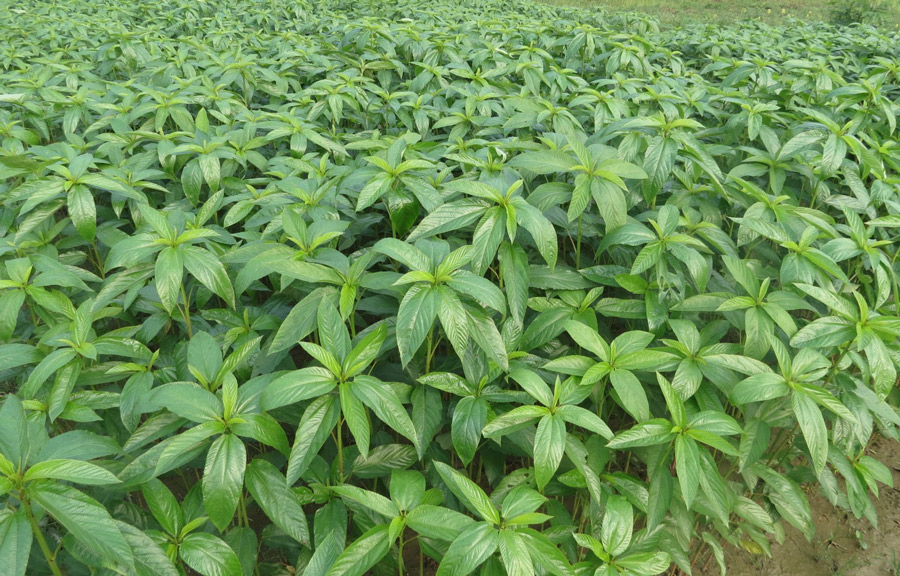Jute is perhaps the most important of all bast fibers. The fiber is obtained from the stems of two cultivated species of Corchorus, namely, C. Capsularis L. and C. olitorius L.
It is mostly produced in Asian countries especially China, India, and Bangladesh.
Origin of Jute Plant
The primary center of origin of C. olitorius is Africa with a secondary center in India while C. capsular is originated from southern China.
Jute Ecology
Jute requires high temperatures, about 27-32°C, and rainfall of at least 1500mm. Both species are short-day plants but there are cultivars that are a bit too sensitive to photoperiod.
Soils required for good growth should be sandy loam with near-neutral pH of 6-7.
C. capsularis can withstand occasional flooding when the plants are over 1m tall but C. olitorius does not withstand waterlogging.
Jute Botany
Jute is a herbaceous, little branched annual plant. It has a taproot system with lateral branches. The straight slender stems can grow up to 4m tall.
The best fibers occur in the outer portion of the stem, interspersed with thin-walled tissues of phloem.
The fibers consist of sclerenchyma bundles. The leaves are simple and are arranged alternately on the stem.
The lamina is lanceolate with serrate margins and has peculiarly curved bristles (auricles) near the base.
The flowers are solitary or arranged in few-flowered comes opposite the leaves.
The two species of jute are quite similar botanically but differ in a number of ways. C. olitorius is a much taller species; the leaves are larger with a shinning upper and a rough undersurface and with no bitter taste.
The yellowish flowers are larger in size and develop into a long, cylindrical, ridged capsules with an elongated beak.
The seeds are small, blueish green to grey or even black in color. The fruits of C. capsularis are round or globular and seeds are brown.
The fibers of C. olitorius are usually finer, softer, stronger, and more lustrous than those of C. capsularis but are either yellow, red or grey.
The fibers of C. capsularis are white and hence called white jute.
Cultural Practices of Jute Plants
The seeds are down broadcast or drilled in rows. With broadcasting, seedrate is 6-9kg/ha for C.olitorius and 11-13kg/ha for C. capsularis.
After germination, the stand is thinned out to 10x10cm. With drilling, the row spacing is 20-30cm and the stand is thinned to 6-8cm within rows.
The seed requirement is thus reduced to about 5 and 7kg/ha for C. olitorius and C. capsularis respectively.
Weeds can be controlled by how weeding about 2-3 times. Fertilizer can be applied at the rate of 200kg/ha of NPK 15.15.15.
Harvesting And Processing of Jute Plants
The best fiber quality is achieved when jute is harvested early when about 50% of the plants are in a pod; with C. olitorius at 90 days after planting, C. capsularis at 100 days.
Higher yields are achieved by harvesting after 100 days but the fibers are then of lesser quality.
The plants are harvested by cutting close to the ground with a sickle or mechanically. For the extraction of the fibers, the whole plant is retted in water for 8-10 days.
After this, the fibers are separated by hand, washed, and hung in the sun to dry.
The fiber content varies, depending on the cultivar and time of harvesting, between 4.5 and 7.5% (average 5.5%) of the fresh weight of stems.
Yield
The average yield is about 1.5t/ha of fibers but under good management yields of 3.5-4t fibers/ha can be obtained.
Uses of Jute Plants
The fibers are used as packing materials because of their low elasticity and their high capacity to absorb water.
Most of the fibers produced (75%) are used to make sacks, bags, and some for coarse yarns, which are used as the backing materials for carpets and linoleum.
The stem residues after retting can be used for fencing and firewood. They have also been found suitable for papermaking and binding panels. C. olitorius is extensively grown as a vegetable in many African countries.
In Nigeria, it is very popular in the southwest zone and known locally as ‘Ewedu‘.
Diseases affecting Jute Plants
Jute suffers relatively little from diseases and pests. The more common ones are seedling blight or stem rot caused by Macrophomina spp and damping-off caused by Diplodia corchori.
Pests affecting Jute
These include jute semi looper (Anomie sabulifera), caterpillars of a number of moths (Diascrisia obliqua and Prodenia litura), larvae of the jute apion (Apion corchori).








